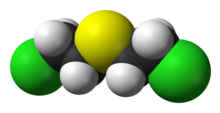Bis(2-chloroethyl)sulfide is the organosulfur compound with the formula (ClCH2CH2)2S. It is a prominent member of a family of cytotoxic and blister agents known as mustard agents. Sometimes referred to as mustard gas, the term is technically incorrect: bis(2-chloroethyl)sulfide is a liquid at room temperature. In warfare it was dispersed in the form of a fine mist of liquid droplets.[4][5]

| |

| |

| |
| Names | |
|---|---|
| Preferred IUPAC name
1-Chloro-2-[(2-chloroethyl)sulfanyl]ethane | |
| Other names
Bis(2-chloroethyl) sulfide
HD Iprit Schwefel-LOST Lost Sulfur mustard Senfgas Yellow cross liquid Yperite Distilled mustard Mustard T- mixture 1,1'-thiobis[2-chloroethane] Dichlorodiethyl sulfide | |
| Identifiers | |
3D model (JSmol)
|
|
| 1733595 | |
| ChEBI | |
| ChEMBL | |
| ChemSpider | |
| EC Number |
|
| 324535 | |
| KEGG | |
PubChem CID
|
|
| UNII | |
| |
| |
| Properties | |
| C4H8Cl2S | |
| Molar mass | 159.07 g·mol−1 |
| Appearance | Colorless if pure. Normally ranges from pale yellow to dark brown. Slight garlic or horseradish type odor.[1] |
| Density | 1.27 g/mL, liquid |
| Melting point | 14.4 °C (57.9 °F; 287.5 K) |
| Boiling point | 217 °C (423 °F; 490 K) begins to decompose at 217 °C (423 °F) and boils at 218 °C (424 °F) |
| 7.6 mg/L at 20°C[2] | |
| Solubility | Alcohols, ethers, hydrocarbons, lipids, THF |
| Hazards | |
| Occupational safety and health (OHS/OSH): | |
Main hazards
|
Flammable, toxic, vesicant, carcinogenic, mutagenic |
| GHS labelling:[3] | |
 
| |
| Danger | |
| H300, H310, H315, H319, H330, H335 | |
| P260, P261, P262, P264, P270, P271, P280, P284, P301+P310, P302+P350, P302+P352, P304+P340, P305+P351+P338, P310, P312, P320, P321, P322, P330, P332+P313, P337+P313, P361, P362, P363, P403+P233, P405, P501 | |
| NFPA 704 (fire diamond) | |
| Flash point | 105 °C (221 °F; 378 K) |
| Safety data sheet (SDS) | External MSDS |
| Related compounds | |
Related compounds
|
Nitrogen mustard, Bis(chloroethyl) ether, Chloromethyl methyl sulfide |
Except where otherwise noted, data are given for materials in their standard state (at 25 °C [77 °F], 100 kPa).
| |
Synthesis edit
Bis(2-chloroethyl)sulfide has been prepared in a variety of ways. In the Depretz method, sulfur dichloride is treated with ethylene:
- SCl2 + 2 C2H4 → (ClC2H4)2S
In the Levinstein process, disulfur dichloride is used instead:[6][failed verification][7]
- S2Cl2 + 2 C2H4 → (ClC2H4)2S + 1⁄8 S8
In the Meyer method, thiodiglycol is produced from chloroethanol and potassium sulfide, and the resulting diol is then treated with phosphorus trichloride:[8][9]
- 3 (HOC2H4)2S + 2 PCl3 → 3 (ClC2H4)2S + 2 P(OH)3
In the Meyer–Clarke method, concentrated hydrochloric acid (HCl) is used instead of PCl3:
- (HOC2H4)2S + 2 HCl → (ClC2H4)2S + 2 H2O
Thionyl chloride and phosgene, the latter of which is also a choking agent, have also been used as chlorinating agents. These compounds have the added advantage in that if they are used in excess, they remain as impurities in the finished product and can therefore produce additional mechanisms of toxicity.
Reactions edit
The idealized combustion of mustard gas in oxygen produces hydrochloric acid and sulfuric acid, in addition to carbon dioxide and water:
- (ClC2H4)2S + 7 O2 → 4 CO2 + 2 H2O + 2 HCl + H2SO4
Bis(2-chloroethyl)sulfide reacts with sodium hydroxide, giving divinyl sulfide:
- (ClC2H4)2S + 2 NaOH → (CH2=CH)2S + 2 H2O + 2 NaCl
Sodium ethoxide acts similarly.
Safety edit
Upon skin contact or inhalation, bis(2-chloroethyl)sulfide is a nonspecific toxin. It is a strong alkylating agent, which affects DNA, RNA, and proteins.[10]
See also edit
References edit
- ^ FM 3–8 Chemical Reference handbook, US Army, 1967
- ^ Mustard agents: description, physical and chemical properties, mechanism of action, symptoms, antidotes and methods of treatment. Organisation for the Prohibition of Chemical Weapons. Accessed June 8, 2010.
- ^ "Pubchem".
- ^ "Sulfur Mustard: Blister Agent". Centers for Disease Control and Prevention. 25 May 2023. Archived from the original on 2023-11-01. Retrieved 2023-12-28.
- ^ Ghabili, Kamyar; Agutter, Paul S.; Ghanei, Mostafa; Ansarin, Khalil; Panahi, Yunes; Shoja, Mohammadali M. (2011). "Sulfur mustard toxicity: History, chemistry, pharmacokinetics, and pharmacodynamics". Critical Reviews in Toxicology. 41 (5): 384–403. doi:10.3109/10408444.2010.541224. PMID 21329486. S2CID 28491672.
- ^ Stewart, Charles D. (2006). Weapons of mass casualties and terrorism response handbook. Boston: Jones and Bartlett. p. 47. ISBN 0-7637-2425-4.
- ^ "Chemical Weapons Production and Storage". Federation of American Scientists. Archived from the original on August 11, 2014.
- ^ E. M. Faber and G. E. Miller (1932). "β-Thiodiglycol". Organic Syntheses. 12: 68. doi:10.15227/orgsyn.012.0068.
- ^ Institute of Medicine (1993). Chapter 5: Chemistry of Sulfur Mustard and Lewisite. The National Academies Press. ISBN 0-309-04832-X.
{{cite book}}:|work=ignored (help) - ^ Kehe, Kai; Szinicz, Ladislaus (2005). "Medical aspects of sulphur mustard poisoning". Toxicology. 214 (3): 198–209. doi:10.1016/j.tox.2005.06.014. PMID 16084004.
